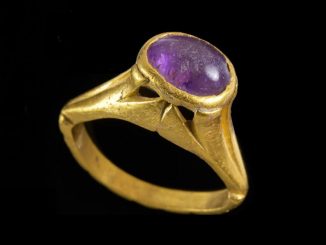Scientists found dozens of perforated pieces of snail shells dating back 142,000 – 150,000 years, most likely used to make necklaces or bracelets.

The world’s oldest snail shell used as jewelry in a cave in Morocco. Photo: A. Bouzouggar/Science Advances
People have been wearing necklaces, bracelets, earrings and other types of jewelry since time immemorial. However, the discovery of dozens of jewelry beads made from sea snail shells in Bizmoune cave, western Morocco, shows that this practice appeared much earlier than scientists once thought. New research published in the journal Science Advances on September 22.
Anthropologist Steven Kuhn at the University of Arizona collaborated with researchers from Morocco’s National Institute of Archaeological Sciences and Heritage to conduct excavations from 2014 to 2018 at Bizmoune Cave and found a total of 33 beads. jewelry made from sea shells. They date back 142,000 – 150,000 years, making them the oldest jewelry ever discovered in the world.
The pieces of snail shell are about 1 cm wide with a round hole in the middle. They show signs of wear on the inside, meaning they may have been strung on a necklace or bracelet and used frequently. “Beads may have been a way for ancient people to express their identity through clothing. They show that this has been going on for hundreds of thousands of years, and people were interested in communicating with different groups.” bigger than just family and close friends,” Kuhn said.
The 33 beads in Bizmoune Cave are similar to many other beads found in Africa, but previous specimens were dated no more than 130,000 years ago. All the counties in North Africa belong to the Aterian culture. The earliest relics of this culture existed from 150,000 years ago and the latest 20,000 years ago.
The bead jewelry that the Aterians made and used was likely a form of non-verbal communication, according to Kuhn. Anthropologists are uncertain about when language emerged, so it’s possible that Aterians relied entirely on nonverbal methods to share information.
Kuhn believed that the message or meaning of the bead was important and timeless, as Aterians chose to create ornaments that would last to convey that message. Meanwhile, prehistoric people often adorned their faces and bodies with charcoal or ocher for ritual or communication purposes, but these were only temporary.
Kuhn and his colleagues weren’t sure exactly what the Aterians wanted to convey with their jewelry. The first theory is that jewelry beads act like name tags or identification badges. Different individuals, families, clans or villages may want to be distinguishable, especially as the number of people in the area increases with the development of the Stone Age.
The second theory is that bead jewelry is a status symbol. Depending on the design, shell beads can help people with political, social, cultural, economic, spiritual, or medical power make a difference. Another possibility is that Aterians wore jewelry for the same reasons as most people today, which is that they liked the way it looked and believed it would enhance their appearance.


